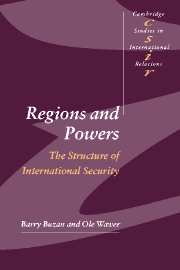Book contents
- Frontmatter
- Contents
- List of illustrations
- Preface
- List of abbreviations
- 1 Patterns of regional security during the Cold War
- 2 Patterns of regional security post-Cold War
- Part I Introduction: developing a regional approach to global security
- Part II Asia
- Part III The Middle East and Africa
- Part IV The Americas
- Part V The Europes
- Part VI Conclusions
- Glossary
- References
- News media
- Index of names
- General Index
- CAMBRIDGE STUDIES IN INTERNATIONAL RELATIONS
Preface
Published online by Cambridge University Press: 05 December 2009
- Frontmatter
- Contents
- List of illustrations
- Preface
- List of abbreviations
- 1 Patterns of regional security during the Cold War
- 2 Patterns of regional security post-Cold War
- Part I Introduction: developing a regional approach to global security
- Part II Asia
- Part III The Middle East and Africa
- Part IV The Americas
- Part V The Europes
- Part VI Conclusions
- Glossary
- References
- News media
- Index of names
- General Index
- CAMBRIDGE STUDIES IN INTERNATIONAL RELATIONS
Summary
Our previous book, Security: A New Framework for Analysis, laid the foundations for thinking about regional security in the context of a wider security agenda and a securitisation approach. It is that thread we pick up here. We sought to bring some clarity to the debate about the ‘new’ security by combining a sectoral approach to the wider security agenda with a constructivist (‘securitisation’) understanding of what separated ‘security’ from routine politics. We solved some specific theoretical problems related to the expanded concept of security and to an ensuing rethinking of the ‘regional’ character of security. We also addressed the tension in the current system between deterritorialising and territorialising processes. Briefly stated, the problem arose because regional security complex theory was developed primarily in relation to the dynamics of the political and military sectors, where, because threats in these sectors travel more easily over short distances than over long ones, distance clearly plays a role in producing regional security complexes. When the concept of security was extended to economic, environmental, and – the part we ourselves have previously contributed most to – identity-related (‘societal’) threats, doubts arose about whether security interdependence in these non-traditional sectors would take a regional form and, if it did, whether it would generate the same region across the sectors, or different regions according to the sector. It was thus necessary to build a conceptual apparatus able both to handle the extended concept of security and to avoid the ‘everything is security’ watering-down of the concept.
- Type
- Chapter
- Information
- Regions and PowersThe Structure of International Security, pp. xvi - xixPublisher: Cambridge University PressPrint publication year: 2003

